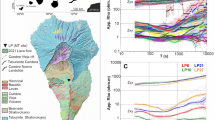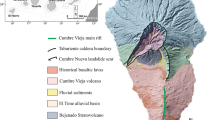Abstract
Two magnetotelluric (MT) surveys were carried out on the Mt. Etna volcano after two of the most intense eruptions of the last 30 years which took place in summer 2001 and winter 2002–2003. Surveying was pursued for two main reasons. First, we sought to contribute to the definition of the first-order structure and physico-chemical state (temperature, fluids, melts) of a volcano that has been extensively explored and monitored by means of various geophysical methods, but where only few electrical and electromagnetic surveys have been performed. Secondly, we acquired MT data in the same sites in the two different surveys with the aim of monitoring the possible changes of the first-order structure, since conditions are expected to vary on an active volcano such as Etna, and are supposed to be linked to the eruptive events. Soundings have been acquired in an E-W 10 km-long profile across the southern flank of Mt. Etna, at a distance of almost 6 km south from the Central Crater. The first survey was carried out three months after the 2001 eruption. Inverse models define a pronounced (4 km thickness) low resistivity section at a depth of about 1 km b.s.l. to the west. To the east, a low resistivity section is still present, but appears deeper, thinner and more resistive, and a shallow low resistivity anomaly also exists. The shallow anomaly to the east is tentatively correlated with altered and clayey volcanic units and/or temporary groundwater storage. The deep anomalies are interpreted as being due to melt storage at shallow depths which was not exhausted during the eruption. This would be confirmed by the abundance of lava erupted within one year from the end of the survey. The few good sites retrieved in the second survey, carried out a few weeks after the eruption of 2002–2003, confirm the picture defined in the first survey, and provide a better definition of the bottom of the deep anomaly located in the sedimentary basement.






Similar content being viewed by others
References
Aloisi M, Cocina O, Neri G, Orecchio B, Privitera E (2002) Seismic tomography of the crust underneath the Etna volcano, Sicily. Phys Earth Planet Int 134:139–155
Behncke B, Neri M (2003) The July-August 2001 eruption of Mt. Etna (Sicily). Bull Volcanol 65:461–476
Bonaccorso A, Ferrucci F, Patanè D, Villari L (1996) Fast deformation processes and eruptive activity at Mount Etna (Italy). J Geophys Res 101:17467–17480
Bruno N, Caltabiano T, Giammanco S, Romano R (2001) Degassing of SO2 and CO2 at Mount Etna (Sicily) as an indicator of pre-eruptive ascent and shallow emplacement of magma. J Volc Geoth Res 110:137–153
Catalano S, Torrisi S, Ferlito C (2004) The relationship between Late Quaternary deformation and volcanism of Mt. Etna (eastern Sicily): new evidence from the sedimentary substratum in the Catania region. J Volcanol Geotherm Res 132:311–334
Chiarabba C, Amato A, Boschi E (2000) Recent seismicity and tomographic modeling of the Mount Etna plumbing system. J Geophys Res 105(B5):10923–10938
Della Monica G, Di Maio R, Scandone R, Cecere G, Del Negro C, De Martino P, Santochirico F (2004) Electrical modelling of the shallow structural setting of the Cisternazza-Montagnola area (Mt. Etna). Quad Geofis 35:39–44
Del Negro C, Currenti G (2003) Volcanomagnetic signals associated with 2001 flank eruption of Mt.Etna (Italy). Geophys Res Lett 30(7):1357–1360
Di Maio R, Mauriello P, Patella D, Petrillo Z, Piscitelli S, Siniscalchi A (1998) Etna: self-Potential, geoelectric and magnetotelluric measurements. In: P. Gasparini (ed) Data related to eruptive activity, unrest phenomena and other observations on the Italian active volcanoes–1993–1995. Acta Volcanol 10:187–193
Gamble T, Goubau W, Clarke J (1979) Magnetotellurics with a remote-reference. Geophysics 44:53–68
Hirn A, Nicolich R, Gallart J, Laigle M, Cernobori L, ETNASEIS Scientific Group (1997) Roots of Etna volcano in faults of great earthquakes. Earth Planet Sci Lett 148:171–191
Ingham M (1992) Audiomagnetotelluric soundings on White Island volcano. J Volc Geoth Res 50:301–306
Jones AG (1992) Electrical conductivity of the continental lower crust. In: Fountain DM, Arculus RJ, Kay RW (eds) Continental lower crust. Elsevier, Amsterdam pp, 81–143
Kagiyama T, Utada H, Yamamoto T (1999) Magma ascent beneath Unzen Volcano, SW Japan, deduced from the electrical resistivity structure. J Volc Geoth Res 89:35–42
Larsen JC, Mackie R, Manzella A, Fiordelisi A, Rieven S (1996) Robust smooth magnetotelluric transfer function. Geophys J Int 124:801–819
La Torraca GA, Madden TR, Korringa J (1986) An analysis of the magnetotelluric impedance for three dimensional conductivity structures. Geophysics 51:1819–1829
Loddo M, Patella D, Quarto R, Ruina G, Tramacere A, Zito G (1989) Application of gravity and deep dipole geoelectrics in the volcanic area of Mt. Etna (Sicily). J Volc Geoth Res 39:17–39
Massonnet D, Briole P, Arnaud A (1995) Deflation of Mount Etna monitored by spaceborne radar interferometry. Nature 375:567–570
Mauriello P, Patella D, Petrillo Z, Siniscalchi A, Iuliano T, Del Negro C (2004) A geophysical study of the Mount Etna volcanic area. In: Bonaccorso A, Calvari S, Coltelli M, Del Negro C, Falsaperla S (eds) Mt. Etna: volcano laboratory. AGU geophys Mon 143:273–291
Mogi T, Nakama S (1993) Magnetotelluric interpretation of the geothermal system of the Kuju volcano, southwest Japan. J Volcanol Geotherm Res 56:297–308
Muller A, Haak V (2004) 3-D modeling of the deep electrical conductivity of Merapi volcano (Central Java): integrating magnetotellurics, induction vectors and the effects of steep topography. J Volcanol Geotherm Res 138:205–222
Murru M, Montuori C (1999) The location of magma chamber at Mt. Etna, Italy, mapped by b-values. Geophys Res Lett 26(16):2553–2556
Ogawa YN, Matsushima H, Oshima H, Takakura S, Utsugi M, Hirano K, Igarashi M, Doi T (1998) A resistivity cross-section of Usu volcano, Hokkaido, Japan, by audiomagnetotellurics soundings. Earth Planet Space 50(4):339–346
Oskooi B, Pedersen LB, Smirnov M, Árnason K, Eysteinsson H, Manzella A (2005) The deep geothermal structure of the Mid-Atlantic ridge deduced from MT data in SW Iceland. Phys Earth Planet Int 150:183–195
Revil A, Finizola A, Sortino F, Ripepe M (2004) Geophysical investigation at Stromboli volcano, Italy: implications for ground water flow. Geophys J Int 157:426–440
Rodi W, Mackie RL (2001) Nonlinear conjugate gradients algorithm for 2-D magnetotelluric inversion. Geophysics 66:174–187
Scarlato P, Poe BT, Freda C, Gaeta M (2004) High-pressure and high-temperature measurements of electrical conductivity in basaltic rocks from Mount Etna, Sicily, Italy. J Geophys Res 109:B02210 DOI 10.1029/2003JB002666
Sharp ADL, Davis PM, Gray F (1980) A low velocity zone beneath Mount Etna and magma storage. Nature 287:587–591
Schnegg PA (1997) Electrical structure of Plaine des Sables caldera, Piton de la Fournaise volcano (Réunion island). Ann Geofis 40:305–317
Smith T (1995) Understanding telluric distorion matrices. Geophys J Int 122:219–226
Swift JR (1967) A magnetotelluric investigation of an electrical conductivity anomaly in the southwestern United States. PhD Thesis, MIT, Boston
Tanguy JC, Condomines M, Kieffer G (1997) Evolution of the Mount Etna magma: constraints on the present feeding system and eruptive mechanism. J Volc Geoth Res 75:225–250
Vozoff K (1991) The magnetotelluric method. In: Nabighiam MN (ed) Electromagnetic methods in applied geophysics. SEG, Tulsa, 2B, pp 641–711
Wannamaker PE (1999) Affordable magnetotellurics: interpretation of MT sounding profiles from natural environments. In: Oristaglio M, Spies B (eds) Three-dimensional electromagnetics. SEF, Tulsa, pp 349–374
Weaver JT, Agarwal AK, Lilley FEM (2000) Characterization of the magnetotelluric tensor in terms of its invariants. Geophys J Int 141:321–336
Acknowledgements
This research project was supported under the EPOT Project–GNV. We thank Metronix Company for providing the systems, B. Friedrichs for the technical support and N. Praticelli, G. Girardi, A. Maretto for their assistance in the first fieldwork. We also thank S. Trifirò for field assistance and B. Narod for help and valuable advice during the second survey. The useful comments of an anonymous referee and A. Revil improved the paper in its final version.
Author information
Authors and Affiliations
Corresponding author
Additional information
Ediorial responsibility: M. Ripepe
Rights and permissions
About this article
Cite this article
Manzella, A., Zaja, A. Volcanic structure of the southern sector of Mt. Etna after the 2001 and 2002 eruptions defined by magnetotelluric measurements. Bull Volcanol 69, 41–50 (2006). https://doi.org/10.1007/s00445-006-0054-9
Received:
Accepted:
Published:
Issue Date:
DOI: https://doi.org/10.1007/s00445-006-0054-9




